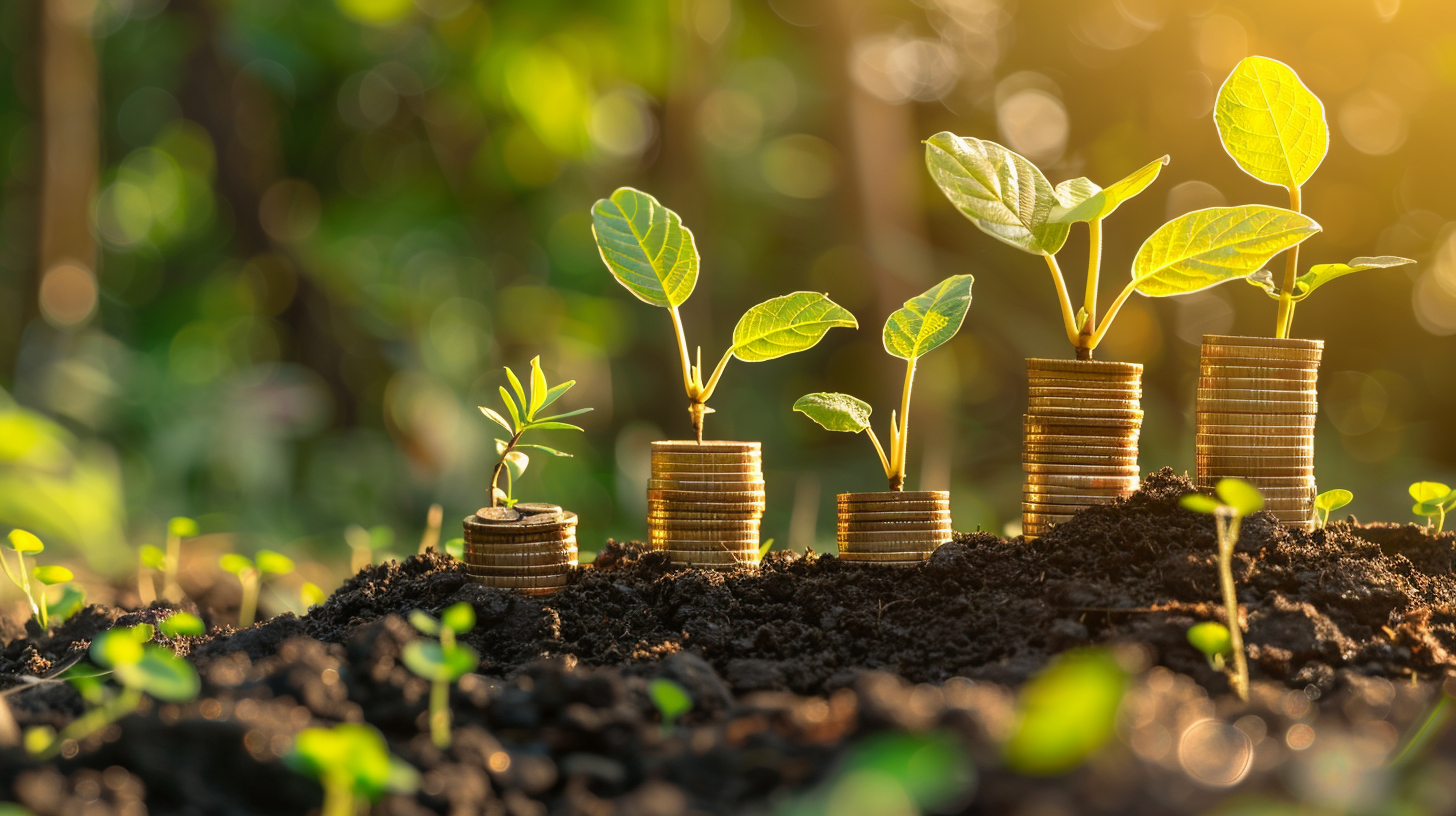Table of Contents Show
As the tide turns in the investment world, we’re witnessing a green wave that’s not just making ripples but creating tsunamis in traditional markets. We’ve observed that sustainable funds are not only holding their ground but, in many instances, outperforming their conventional counterparts. This shift isn’t just a stroke of luck; it’s built on solid foundations of societal shifts, regulatory changes, and technological advancements. We’re at a pivotal moment where the financial benefits of green investing are becoming too significant to ignore. However, the journey isn’t without its hurdles. Join us as we explore the forces propelling this green surge and consider what lies ahead for investors keen on aligning their portfolios with their values.
Key Takeaways
- Sustainable funds often deliver higher returns than traditional funds, demonstrating their market resilience.
- Green investing is driven by increasing demand, regulatory support, and the rise in investor awareness.
- Environmental benefits from green investments include promoting renewable energy and driving policy and technological innovations.
- Geographic trends show Europe and North America leading in green investing, with growing interest in Asia-Pacific due to governmental support.
Defining Green Investing
Green investing focuses on allocating capital towards projects and companies that are environmentally sustainable and responsible. We’re talking about putting our money where our hearts are, ensuring that every dollar we invest is also a vote for a healthier planet. It’s about breaking free from the traditional constraints of investment strategies that overlook the long-term health of our environment. We’re not just looking for returns; we’re seeking a transformation in how businesses operate, pushing them towards practices that preserve our planet for future generations.
This approach isn’t just about avoiding harm; it’s about actively doing good. We’re diving into opportunities that range from renewable energy to sustainable agriculture, clean tech, and beyond. It’s a broad spectrum, and that’s the beauty of it. We’re not limited to one sector or industry. Instead, we’re exploring a universe of possibilities that align with our values of sustainability and responsibility.
Historical Performance Analysis
Let’s take a closer look at how sustainable funds have historically outperformed their traditional counterparts in the market. It’s been quite a journey, uncovering the financial benefits of aligning investments with environmental and social governance principles. We’ve seen a significant shift where green investing isn’t just about making a positive impact on the world, but it’s also about securing robust returns for investors who value their freedom to choose a sustainable future.
To give you a clearer picture, we’ve compiled data comparing the performance of sustainable funds to traditional funds over various periods. This table illustrates not just the potential for higher returns, but also the resilience of green investments in turbulent times.
| Period | Sustainable Funds Return | Traditional Funds Return |
|---|---|---|
| 1 Year | +15.2% | +10.8% |
| 3 Years | +12.9% | +9.7% |
| 5 Years | +10.4% | +8.3% |
| 10 Years | +8.1% | +6.5% |
As evident from the table, sustainable funds have consistently outperformed traditional funds across different time frames. This historical performance analysis isn’t just a demonstration to the financial viability of green investing; it’s a clarion call to investors seeking freedom in their choice of investments. It underscores the fact that you don’t have to compromise on your values or your returns. Opting for sustainable funds can indeed offer the best of both worlds, paving the way for a financially stable and environmentally conscious future.
Key Drivers of Growth
Having observed the impressive historical performance of sustainable funds, we now turn our attention to the key factors that have fueled this growth. It’s clear that investors are increasingly demanding options that not only offer financial returns but also align with their values for a sustainable future. This shift in investor sentiment is a major driver, pushing the finance industry towards green investing.
We’re seeing a surge in awareness about how investments can impact the world. People want their money to work for them in ways that don’t compromise the planet. They’re choosing funds that prioritize companies with sustainable practices, driving a significant portion of growth in this sector.
Another factor is the improved access and information available to investors. Today, it’s easier than ever to find and invest in green funds. With a few clicks, investors can compare funds, understand their impact, and make informed decisions that align with their personal and financial goals. This ease of access has opened the doors to a broader audience, including younger investors who are particularly passionate about environmental issues.
Finally, regulatory support has played a critical role. Governments and regulatory bodies around the world are setting ambitious environmental targets and supporting green finance initiatives. This regulatory environment not only encourages but, in some cases, mandates investment in sustainable projects, further accelerating the growth of green investing.
Together, these factors create a powerful momentum for sustainable funds. As investors, we’re not just choosing where to put our money; we’re choosing the kind of future we want to invest in.
Environmental Impact Benefits
Beyond the financial returns, sustainable funds offer significant advantages in reducing our carbon footprint and preserving natural resources for future generations. We’re not just investing in the present; we’re securing a healthier planet for our kids and their children. It’s about making choices that guarantee freedom and quality of life for all, far into the future. Here’s how sustainable funds are leading the charge in making a positive environmental impact:
- Promoting renewable energy sources: By investing in companies that produce or support solar, wind, and hydro power, we’re helping to decrease reliance on fossil fuels.
- Supporting companies with green policies: We’re backing businesses that prioritize sustainability in their operations, from reducing emissions to conserving water.
- Encouraging innovation: Our investments drive the development of new technologies that tackle environmental challenges, making green solutions more accessible and efficient.
- Mitigating climate change: Through targeted investments, we’re part of the global effort to reduce greenhouse gas emissions and combat global warming.
- Protecting ecosystems: By supporting companies that uphold high environmental standards, we’re contributing to the preservation of natural habitats and biodiversity.
We’re not just passive observers; we’re active participants in shaping a greener future. By choosing sustainable funds, we’re voting with our dollars for a planet that remains vibrant, diverse, and free for generations to come. It’s an investment in freedom—the freedom to enjoy clean air, water, and a stable climate. Let’s continue to push the boundaries, making choices that reflect our commitment to the environment and our belief in the power of collective action.
Types of Sustainable Funds
After exploring the broad environmental benefits of sustainable investing, we now turn our attention to the various types of sustainable funds available to investors. We’re keen on providing you with the knowledge to navigate this burgeoning field, ensuring you’re equipped to make choices that align with your values and financial goals.
First up, we’ve got ESG funds. These focus on companies excelling in environmental, social, and governance criteria. If you’re someone who values corporate responsibility as much as profitability, ESG funds might be your go-to.
Then, there are Green Bonds. These are for investors looking to directly fund projects with environmental benefits, such as renewable energy initiatives or conservation efforts. It’s a way to see your money work towards tangible green outcomes.
Impact investing funds take things a step further. They’re not just about avoiding harm or doing good; they aim to solve specific social or environmental issues through strategic investments. If you’ve got a cause close to your heart, this could be your avenue for making a difference.
Finally, we’ve got SRI funds – Socially Responsible Investing. These funds take a holistic approach, excluding investments in industries like tobacco or firearms and focusing on companies with positive social impacts.
We believe that understanding these options gives you the freedom to shape your financial future in a way that reflects your personal ethics and aspirations. Each type of fund offers a unique pathway to participating in the green investing movement, empowering you to make decisions that align with your vision for a better world.
Comparing to Traditional Investments
We’re now turning our focus to how sustainable funds stack up against traditional investments. We’ll examine performance metrics and weigh risk against reward to see where green investments truly shine. This comparison aims to provide a clear picture of the advantages and potential drawbacks of choosing sustainable over traditional investment options.
Performance Metrics Analysis
Analyzing performance metrics reveals that sustainable funds have consistently outperformed traditional investments in recent years.
Here’s why this matters:
- Higher Returns: Sustainable funds often yield more attractive returns, letting your money work harder for you.
- Market Resilience: They’ve shown remarkable resilience during market downturns, providing a safety net.
- Growth Potential: The green sector’s growth is booming, offering lucrative long-term prospects.
- Consumer Preference Shift: A growing consumer focus on sustainability drives demand and profitability in these investments.
- Regulatory Support: Governments worldwide are backing green initiatives, bolstering these markets.
We’re witnessing a paradigm shift where the pursuit of financial freedom aligns with sustainable living. This isn’t just about making money; it’s about making money in a way that respects our planet and its future.
Risk Vs. Reward Considerations
While exploring the terrain of green investing, it’s important to weigh the risk versus reward, especially when comparing these opportunities to traditional investments. We’re seeing a shift where sustainable funds aren’t just about doing good; they’re performing well, too. But let’s get real, every investment carries its own set of risks. The question we’ve got to ask ourselves is, are we ready to embrace these risks for potentially higher rewards?
Green investments may face market volatility, regulatory changes, and technological advancements. However, we’re in a unique position to capitalize on these changes, driving towards a future where our portfolios do more than just grow—they reflect our commitment to a healthier planet. It’s about balancing our desire for financial freedom with our responsibility to the environment.
Case Studies of Success
Frequently, sustainable funds have demonstrated remarkable success, outpacing their traditional counterparts in various markets. We’ve seen firsthand how these green investments aren’t just about doing good—they’re also about doing well financially. It’s a win-win situation that’s hard to ignore. As we plunge into the case studies of success, we’re not just talking about numbers; we’re showcasing the power of choice and the freedom to invest in a future that aligns with our values.
- Renewable Energy Funds: These funds have soared as the world shifts from fossil fuels to renewable sources. Their performance isn’t just promising; it’s been groundbreaking.
- Green Bonds: Issued to finance environmentally friendly projects, green bonds have seen a surge in demand, offering competitive returns and a clear conscience.
- Sustainable Index Funds: With lower fees and competitive performance, these funds have attracted investors who want to mirror the success of major indices while adhering to sustainable practices.
- Impact Investing Funds: Focused on companies making a positive environmental impact, these funds have outperformed, proving that good deeds and good returns go hand in hand.
- ESG Leaders: Companies leading in Environmental, Social, and Governance (ESG) criteria have witnessed their stock prices outperform lagging peers, highlighting the market’s valuation of sustainable practices.
Our journey into green investing isn’t just about following a trend; it’s about embracing the freedom to choose investments that reflect our commitment to the planet and our future. By focusing on these success stories, we’re not only highlighting the financial gains but also the broader impact of our investment choices.
Investor Demographics
We’ve observed how sustainable funds are outpacing traditional markets, but who’s driving this shift? Let’s explore the age trends and geographic investment patterns defining today’s green investors. Understanding who these investors are can help us predict the future of sustainable investing.
Age Trends Analysis
A closer look at investor demographics reveals that younger generations, particularly millennials, are driving the surge in green investing. They’re not just thinking about the now; they’re looking ahead, choosing investments that promise a healthier planet for their future.
Here’s why they’re leading the charge:
- Millennials prioritize sustainability and ethical considerations in their investment choices.
- They’re tech-savvy, using platforms that offer easy access to green funds.
- Social media influence and peer discussions encourage their green investment decisions.
- Many are investing for the first time and prefer options aligning with their values.
- They see green investing as both a moral duty and a savvy financial strategy.
This shift towards green investing isn’t just a trend; it’s a movement, with younger investors at the helm, steering us towards a more sustainable future.
Geographic Investment Patterns
Delving into geographic investment patterns reveals that certain regions are leading the way in green investing, reflecting diverse investor demographics and priorities. We’re seeing an unmistakable trend where freedom-loving individuals across various continents are choosing to put their money where their values lie. It’s a powerful expression of financial liberty, aligning investments with environmental sustainability.
| Region | Percentage of Green Investments | Notable Trends |
|---|---|---|
| Europe | 45% | Leading in ESG integration |
| North America | 30% | Rapidly growing interest |
| Asia-Pacific | 25% | Increasing governmental support |
This table emphasizes that while Europe is at the forefront, North America and the Asia-Pacific region are not far behind. Each area has unique characteristics driving its green investment surge, showcasing a global shift towards sustainable finance that champions both planet and profit.
Regulatory and Policy Support
Regulatory frameworks and policy incentives have greatly strengthened the performance of sustainable funds compared to traditional markets. Governments and regulatory bodies worldwide are recognizing the pivotal role of finance in achieving sustainability goals. They’re rolling out measures that not only encourage but, in some cases, mandate investments in green and sustainable projects. This shift isn’t just about adhering to regulations; it’s about seizing the immense opportunities that come with moving to a greener economy.
Here are key ways in which regulatory support is making a difference:
- Tax Incentives: Investors are benefiting from tax breaks and credits for putting their money into sustainable ventures, making these investments financially attractive.
- Disclosure Requirements: Enhanced transparency obligations for companies mean investors have clearer insights into which companies are truly green, enabling more informed decisions.
- Green Bonds: The issuance of green bonds is being supported by policies, providing a straightforward way for investors to contribute to environmental projects.
- Subsidies for Renewable Energy: Governments are pumping money into renewable energy sectors, reducing investment risks and boosting the confidence of investors.
- Carbon Pricing Mechanisms: By putting a price on carbon emissions, regulators are penalizing polluters and rewarding green companies, hence tilting the market in favor of sustainable investments.
We’re embracing these changes because they align with our desire for freedom—the freedom to choose a future that is sustainable and prosperous. Through regulatory and policy support, we’re not just passively watching the transformation; we’re actively participating in shaping a market that values our planet and our future.
Risks and Challenges
While the regulatory support for sustainable investments offers numerous benefits, we must also acknowledge the risks and challenges that come with green investing. It’s important to recognize these hurdles not as deterrents but as opportunities to innovate and adapt. Our journey towards a greener future demands we face these challenges head-on, ensuring our freedom to choose a sustainable path remains unhampered.
| Challenge | Emotional Impact |
|---|---|
| Greenwashing | Feeling misled and frustrated as investments that seemed eco-friendly turn out to be less so. |
| Regulatory Uncertainty | Anxiety over changing policies and how they might affect the viability of green investments. |
| Market Volatility | Stress from the unpredictable shifts in the green market, affecting returns and stability. |
| Limited Historical Data | Concern about the lack of past performance data to guide future green investment decisions. |
| Dependency on Technology | Worry over the reliance on unproven or emerging technologies that green investments often depend on. |
We’re maneuvering a landscape where the line between genuine sustainability and greenwashing can be thin, causing frustration and doubt. The ever-changing regulatory environment adds a layer of uncertainty, challenging our ability to plan long-term investments. Additionally, the green market’s volatility can test our resolve, pushing us to stay informed and resilient. The scarcity of historical data on green investments limits our ability to predict outcomes, while our dependency on evolving technologies introduces an element of risk that we must be prepared to manage. Together, we can confront these challenges, armed with knowledge and a commitment to sustainability, ensuring our financial freedom and a healthier planet for future generations.
Future Trends and Predictions
Looking ahead, we can anticipate that green investing will increasingly become a fundamental component of global finance, reshaping how we approach sustainability in the market. As we navigate this change, we’re not just talking about a trend; we’re witnessing a revolution that aligns financial growth with the well-being of our planet. It’s about giving people the freedom to make investments that reflect their values, without sacrificing returns. Here’s why we’re optimistic about what’s to come:
- Widespread adoption of green technologies: As these technologies become more cost-effective, they’ll naturally attract more investment.
- Regulatory support: Governments worldwide are setting ambitious environmental targets, which will likely include incentives for sustainable investments.
- Growing consumer demand: More people want to buy from and invest in companies that take their environmental responsibilities seriously.
- Increased transparency and data availability: This will make it easier for investors to assess the true sustainability of their investments.
- Innovation in green finance products: Expect to see a wider range of options that cater to various risk appetites and financial goals.
We’re not just looking at a future where green investing is a nice-to-have; it’s becoming a must-have. It’s about empowering ourselves to make choices that benefit our wallets, our planet, and future generations. As we move forward, the freedom to invest in a sustainable future isn’t just a possibility—it’s a priority. Let’s embrace this change with open arms and open portfolios, ready to redefine what it means to invest wisely.
How to Start Investing Green
Given our optimism about the future of green investing, let’s explore how you can begin your journey in sustainable investing. It’s about aligning our financial goals with our values, ensuring that our investments contribute to a healthier planet. First up, we need to educate ourselves. Knowledge is power, and understanding the basics of green investing is essential. We’re talking about diving into what makes an investment ‘green’ and recognizing the sectors and companies leading the charge in sustainability.
Next, let’s start small. We don’t have to overhaul our entire portfolio overnight. It’s about taking those first steps, perhaps by choosing a green mutual fund or ETF that aligns with our values and investment goals. Dipping our toes in the water allows us to gradually shift towards more sustainable investments as we grow more confident.
Another key step is to use the tools at our disposal. Numerous apps and platforms make green investing accessible to everyone, regardless of how much you have to invest. They can help us track our investments’ impact, ensuring we’re not just making money, but making a difference.
Lastly, let’s talk to a financial advisor. They can offer personalized advice tailored to our unique financial situation and goals. A professional can help us navigate the green investing landscape, ensuring our portfolio is both profitable and principled.
Measuring Success Beyond Profits
In green investing, we measure success not just by the profits we earn but also by the positive impact our investments have on the environment. It’s about embracing a broader vision of progress, where financial growth goes hand in hand with environmental stewardship and sustainability. We’re not just chasing the next big return; we’re building a legacy of a healthier planet and a more sustainable economy. This approach empowers us to make decisions that align with our values, giving us the freedom to shape the future we desire.
To highlight how we gauge success in this new investing paradigm, consider these metrics that go beyond traditional profit margins:
- Carbon footprint reduction: We prioritize investments that demonstrate a clear commitment to lowering greenhouse gas emissions.
- Renewable energy adoption: Our success includes funding projects and companies that advance solar, wind, and other renewable energy sources.
- Sustainable resource usage: We look for opportunities in companies that utilize resources responsibly, ensuring long-term ecological balance.
- Social impact: Investments that contribute to community well-being and create meaningful, well-paying jobs are a marker of our success.
- Innovation in sustainability: We celebrate when our investments support breakthroughs in green technology and sustainable practices.
Conclusion
So, we’ve all hopped on the green investing bandwagon, haven’t we? Watching our money grow in the lush forests of sustainable funds while traditional markets are still playing in the sandbox. It’s like we’ve all become eco-warriors overnight, armed with portfolios that would make Mother Nature proud. But let’s not forget, amidst our green-tinted glasses, the rollercoaster of risks and challenges. Here’s to hoping our green dreams don’t turn into compost. Ready to plant more money trees?








